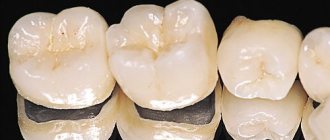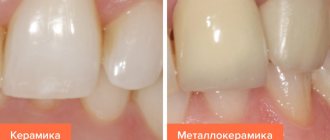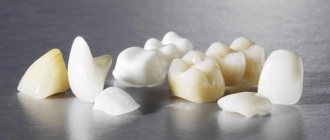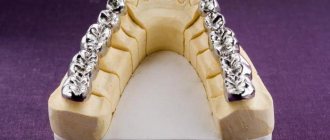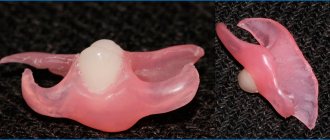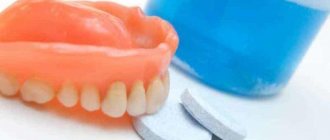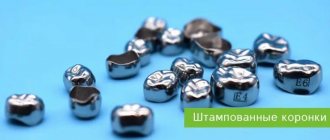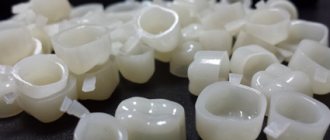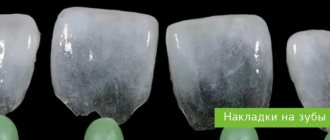- choice of prosthetic technique;
- selection of material for the prosthesis.
The range of materials for dental prosthetics is now wide, which is better? Metal, plastic or ceramics, or maybe a combination of them? In this article we will try to highlight all the features of metal-ceramic prostheses, as well as the pros and cons of the increasingly popular prostheses made of metal-free ceramics.
What is cermet?
When we say “metal-ceramics,” we most often mean crowns and bridges on a metal frame coated with ceramic. Otherwise, it is an orthopedic base made of metal, repeating the shape of a tooth ground for a crown, which is covered on top with a layer of thin ceramics. Ceramic metal is less likely than other materials to cause allergies. Metal-ceramics are used mainly for dental prosthetics in the chewing region, where preference is given not so much to aesthetic qualities as to reliability and functionality.
Cost of dental prosthetics
| Service | Service cost |
| Metal ceramics types of crowns | from 19,000 rub. (for 1 unit) |
| All-ceramic restorations | from 56,000 rub. (for 1 unit) |
| Zirconium oxide | from 56,000 rub. (for 1 unit) |
| Prosthetics on implants | from 26,000 rub. (for 1 unit) |
| Computer simulation of CEREC | from 70,000 rub. (for 1 unit) |
| "All-on-4" | from 260,000 rub. |
- Computer modeling and manufacturing system for ceramic restorations “CEREC” (Germany)
- All-ceramic restorations
- Zirconium oxide
- Prosthetics on implants
SIGN UP FOR A CONSULTATION
Prosthetics with metal-ceramics.
As already noted, metal-ceramics have found their application more in the prosthetics of chewing teeth, where the main thing is strength, not appearance. However, this does not mean that metal ceramics are completely devoid of aesthetics, not at all. The widest range of ceramic coatings allows metal-ceramic crowns to perfectly imitate the shade and structure of natural tooth tissue.
The problem may arise when prosthetics are placed on the front teeth. It is as follows: a dark metal frame can show through a layer of ceramics, that is, the metal simply shines through the translucent coating. Therefore, when replacing anterior teeth, it is most often recommended to use metal-free ceramics or ceramics based on zirconium (zirconium dioxide) - this is, in fact, the same metal ceramics, but the frame material is white metal - zirconium, by the way, is absolutely biocompatible with the human body .
Removable prosthetics
Due to the fact that the Dentistry Best clinic was initially created as a high-tech clinic, removable prosthetics are mainly represented by removable dentures on implants, conditionally removable dentures, as well as clasp dentures on a metal and nylon frame.
Removable dentures on implants are made in cases of complete absence of teeth and very significant atrophy of the jaw bone tissue. In such a situation, it is much easier and significantly less traumatic for the patient to install 4-5 implants and make a removable prosthesis that is fixed on them, than to undergo lengthy and unpleasant procedures for building up bone tissue, then use temporary prostheses for a long time and only after a year or a year and a half receive permanent prostheses .
You may have a natural question: why is implantation needed at all, if in the end the patient still receives removable dentures?
But the whole point is that removable dentures on implants and simply complete removable dentures are absolutely incomparable things.
Dentures on implants do not need to be removed at night and stored in a “cup”. They are much more comfortable than conventional dentures, do not cover the hard palate, are perfectly fixed in the oral cavity, provide full chewing, and have a beautiful appearance.
Complete removable maxillary denture on implants and complete removable maxillary denture
Another type of prosthesis on implants is the so-called conditionally removable dentures .
They are also recommended in conditions of insufficient bone volume, but differ in that they are attached to implants through screw fixation. That is, the patient cannot remove such a prosthesis and for him it is a non-removable structure. This prosthesis is removed only by a doctor and only for hygienic procedures for cleaning implants using a special ultrasound device “Vector”.
And finally, clasp dentures . Made for partial absence of teeth.
Unlike plate dentures, they ensure the transfer of chewing pressure not only to the mucous membrane of the prosthetic field, but also to the remaining teeth, thus increasing the chewing efficiency of the dentures.
Today, thanks to the widespread introduction of new materials, it has become possible to replace the metal frame in such prostheses with nylon, which is lighter, more elastic and, of course, more aesthetic.
Clasp prosthesis of the lower jaw on a nylon frame
Metal-ceramic prostheses.
What is a metal-ceramic prosthesis upon closer examination? First of all, it is a metal frame covered with a layer of hypoallergenic ceramics. If we compare modern metal-ceramic prostheses with their predecessors made of various composites, we will see the undoubted advantages of metal-ceramics:
- firstly, metal-ceramics reproduces the color and texture of natural tooth tissues quite well;
- secondly, it does not fade, does not absorb dyes and, therefore, does not change color over time;
- thirdly, dental ceramics used in dentures are hypoallergenic and do not cause rejection, except in rare cases;
- and finally, cermets are very durable.
If we are talking about removable dentures made of metal ceramics, then we are talking about a clasp denture. “Bugel” (clasp) means “arc”, and the prosthesis itself is precisely a metal arch with metal-ceramic crowns attached to it. Removable metal-ceramic structures are used when there are contraindications to installing a permanent metal-ceramic prosthesis.
The need to install a crown on a metal-ceramic tooth
It is advisable to install a metal-ceramic crown to restore a tooth that cannot be restored with filling, for installation on an implant, and also when tooth enamel is highly abrasive. Such prostheses can serve as a replacement for previous metal or plastic ones.
Metal-ceramics restores the natural shape of teeth with high precision and is almost the same in shape and texture. After prosthetics, the patient does not feel discomfort, there are no defects in speech and chewing function. It is practiced to install metal-ceramic dentures on teeth and crowns in the complete absence of dentition. The introduction of crowns is advisable regardless of the type of tooth.
Due to the hygiene and material, the crown is resistant to the influence of pathological microflora, bacteria, and fungi.
In case of abnormalities in the development of the dentition, if inlays or veneers are contraindicated, a crown will be the best option.
During operation, the prosthesis does not change color and is not affected by natural pigments, food coloring, nicotine, caffeine, etc.
Contraindications include:
- allergic reactions to product materials;
- periodontal disease and severe periodontitis;
- malocclusion;
- bruxism;
- low set teeth;
- excessive tooth mobility.
To avoid unwanted reactions and consequences after installing a prosthesis, you must carefully read the contraindications.
Making a crown on a tooth, before and after photos
Advantages and disadvantages of metal ceramics.
Patients who decide to have metal-ceramic prosthetics often ask themselves and their doctor the question: can metal-ceramics cause harm?
If the prosthesis is made by professionals from high-quality certified materials in a laboratory in compliance with relevant standards, then the danger of such prosthetics is minimal and practically eliminated. The materials that are used in the manufacture of metal-ceramic crowns are themselves non-toxic, but, nevertheless, they can behave differently in the oral cavity. For example, nickel in frames made of chromium-nickel alloys can cause an allergic reaction. And structures made from base metals can oxidize over time due to a reaction with saliva.
In general terms, the advantages of metal-ceramic prostheses include their durability and strength, while the disadvantages are the need for deeper treatment of the tissues of a living tooth, as well as exposure of the frame when the gums recede and the metal base is visible through the ceramic (the exception is zirconium crowns).
Strength:
Today, metal-ceramic structures are installed mainly on teeth exposed to significant chewing load, although until quite recently they were used everywhere. Metal-free ceramic crowns, on the contrary, did not enjoy increased popularity due to the fragility of their design, and therefore were mainly used to restore front teeth.
But with the advent of zirconium dioxide frames in dentistry, the situation has changed dramatically. An increasing number of both dentists and patients are inclined to use these new materials for prosthetics of both chewing and frontal teeth.
The ultra-strength of cermets also has a downside. Damage occurs to the teeth in contact with the metal-ceramic prosthesis, which can lead to their premature and excessive wear. Whereas the hardness coefficient of ceramic prostheses based on zirconium dioxide is very close to the hardness coefficient of real teeth, therefore, when in contact with a prosthesis made of metal-free ceramics, the opposing teeth are not injured from the impact load.
Allergy:
Allergies in the design of a metal-ceramic prosthesis are caused not by ceramics, which are hypoallergenic, but by the metals used in the frame. Symptoms of an allergy to metal ceramics may include:
- burning sensation in the gums or tongue;
- metallic taste in the mouth;
- swelling and swelling at the site of contact with the crown.
If you experience any of these phenomena after installing a metal-ceramic crown, contact your dentist immediately. If you are allergic to metal-ceramics, there is a way out - this is replacing the metal-ceramic crown with an all-ceramic metal-free orthopedic structure.
Color:
Dental ceramics allow you to choose any color that perfectly matches the natural color of the patient’s teeth. The shade is carefully selected by the dental technician using a special Vita scale.
A metal-ceramic crown will not change color over time and will not fade because it does not absorb pigment at all, unlike composite materials from which fillings are made. For all the above reasons, metal ceramics do not require special bleaching.
Durability:
The main misconception of happy owners of metal-ceramic prostheses is ignoring the service life of such a structure. All patients are confident that it is enough to install a metal-ceramic crown once and for all, and it will serve for the rest of their lives. Let us immediately refute this false statement; it is not true! No matter how regrettable it may be, the service life of any metal-ceramic prosthesis is limited on average from 5 to 12 years.
The key to the longevity of the prosthesis is its high-quality production using individually and precisely made casts, as well as the patient’s compliance with all recommendations for its care when wearing it.
Dental clinics provide a guarantee for metal-ceramics for a period of one to three years, taking into account the frame material and the clinic’s policy. According to the warranty terms, the crown must maintain its integrity and not be subject to destruction under mechanical influence for a certain period specified in the warranty. The crown may last the stated time, however, remember that the most “popular” reason for the crown to fall out is not its damage, but secondary caries that has developed under the crown. To avoid this situation, do not neglect regular preventive examinations and do not delay replacing worn-out orthopedic structures with new ones.
Ceramic metal, like any other material, has a service life, after which the product made from it wears out and becomes unusable, as it cannot fully perform its functions. Ignoring the service life of metal-ceramic dentures can lead to tooth loss!
Metal ceramics - dentures
Description
Symptoms
Price
Doctors
Similar services
| Name/duration | Cost, rub. |
Fixed prosthetics
| NAME | Price, rub |
| INITIAL APPOINTMENT | |
| Prosthetics on implants: | |
| Abutment (Osstem) (laboratory) | 4950-00 |
| Abutment (Dentium, Straumann) (laboratory) | 7700-00 |
| Metal-free abutment for a permanent crown on an implant using CAD/CAM technology | 6600-00 |
| Individual metal-free abutment | 8690-00 |
| Custom metal abutment | 7700-00 |
| Temporary abutment (Osstem) for a temporary crown on an implant (laboratory) | 4400-00 |
| Temporary abutment (Dentium) for a temporary crown on an implant (laboratory) | 9570-00 |
| Temporary abutment (Straumann) for temporary crown implant (laboratory) | 6820-00 |
| Temporary plastic crown on an implant | 2100-00 |
| Temporary plastic abutment | 2100-00 |
| Custom temporary plastic abutment | 2100-00 |
| Modeling of metal-free plastic structures in the clinic (for 1 unit) | 2100-00 |
| Temporary plastic crown on an implant (laboratory) | 4500-00 |
| Temporary plastic intermediate crown on implants (laboratory) | 4500-00 |
| Titanium base (TiBase) for a temporary crown on an implant | 6400-00 |
| Straumann titanium base (TiBase) for implant crown | 8250-00 |
| Metal-ceramic crown on an implant | 12000-00 |
| Metal-free ceramics based on “Zirconium” on an implant (laboratory) | 22500-00 |
| Metal-free ceramics on an implant using CAD/CAM technology | 21500-00 |
| Clinical screw | 2970-00 |
| Straight abutment Multi (Osstem) | 5940-00 |
| Straight abutment Multi (Dentium) | 12450-00 |
| Straight abutment Multi (Straumann) | 17600-00 |
| Angled Multi Abutment (Osstem) | 8400-00 |
| Angled abutment Multi (Dentium, Straumann) | 19730-00 |
| Protective cap Multi (Ostem) | 4290-00 |
| Protective cap Multi (Dentium) | 2430-00 |
| Protective cap Multi (Straumann) | 6380-00 |
| Burnout cylinder Multi (Osstem) | 4290-00 |
| Burnout cylinder Multi (Dentium, Straumann) | 6830-00 |
| Push-button attachment to implants for removable dentures | 30000-00 |
| Osstem ball abutment | 8400-00 |
| Ball abutment Dentium, Straumann | 12320-00 |
| Set of Osstem retention caps | 3040-00 |
| Set of Dentium retention caps, | 5110-00 |
| Straumann | |
| Beam attachment to implants for removable dentures | 90000-00 |
| Osstem burnout cylinder for beam production | 5850-00 |
| Burnout cylinder Dentium, Straumann for making a bar | 8580-00 |
| Titanium cylinder Osstem for the manufacture of temporary prosthesis on implants | 4620-00 |
| Titanium cylinder Dentium, Straumann for the manufacture of temporary prosthesis on implants | 6930-00 |
All prices
Our doctors
Guzik Andrey Vyacheslavovich experience more than 20 yearsSign up
Silkina Milana Vladimirovna experience more than 10 years Sign up
Metal-ceramic crowns are today one of the optimal materials for dental prosthetics in terms of price, quality and aesthetic appeal. And if earlier their price seemed exorbitant to many, today they are becoming more and more accessible to the widest range of the population.
Metal-ceramic prosthetics has certain advantages over other types, namely:
- Metal-ceramics is suitable for the manufacture of both removable and permanent, simple and bridge prostheses; it is a universal material;
- The basis of the crown is a strong and durable metal alloy, which ensures high wear resistance of the product;
- The metal base reliably protects your own tooth, which is located under the crown, from damage;
- The ceramic coating looks natural and natural; the crown can be made to match the exact color of the patient’s natural enamel;
- Ceramics is a plastic material; it allows you to very accurately recreate the anatomical shape of the tooth, namely the chewing cusps.
- The ceramic coating is smooth, which creates good conditions for hygienic procedures;
- Ceramics does not leave a taste in the mouth, wearing such crowns does not cause any discomfort to the patient;
- Solid service life of metal-ceramics: teeth last about 10-12 years on average.
Metal-ceramic prosthetics also have disadvantages: for example, it is not suitable for front teeth, since the metal is visible through the coating, some patients may experience an allergic reaction to metal, and inserting teeth with metal-ceramics requires preliminary grinding of adjacent teeth.
However, the result obtained with high-quality metal-ceramic prosthetics practically negates these disadvantages: you get a beautiful, natural-looking and durable prosthesis, which has no restrictions in terms of chewing function (unless it’s worth chopping nuts on it), and also does not require special care other than daily cleaning.
Due to these disadvantages, there are also a number of contraindications to metal-ceramic prosthetics: children under 16 years of age, excessive loads on the jaw, and some dental diseases. In all other respects, this type of crown has virtually no contraindications and provides excellent results.
How are metal-ceramic teeth inserted?
The process of installing metal-ceramic teeth takes place in several stages and takes a fairly long period of time, from 10-12 days or more, especially if the oral cavity is prepared before prosthetics. Schematically, the process of installing metal-ceramic teeth can be described as follows:
- Initial appointment with an orthodontist, a mandatory x-ray, which is designed to show the condition of the root canals and other possible problems in the teeth on which metal ceramics are planned to be installed, determination of the prosthetic scheme, selection of materials, determination of the approximate cost of prosthetics.
- Preparing teeth for prosthetics. Abutment teeth that surround the empty space left after extraction, or the remains of the patient’s own tooth, require complete treatment and depulpation - removal of the soft tissue inside the tooth and the nerve. For this purpose, therapeutic treatment and complete filling of the root canals are performed.
- Another unpleasant, but inevitable stage of preparing teeth for metal-ceramic prosthetics is grinding down the supporting teeth. They are given a cone-shaped shape, for which, using a drill, the doctor removes an impressive part of the dentin - about 2 mm from the chewing surface and 1-1.5 mm from the buccal and lingual sides. This is done so that the subsequently placed crown compensates for the lost volume and the tooth retains its anatomical shape, which is familiar and comfortable for the patient. This is also done to ensure that the crown fits tightly on the tooth.
- After completing the preparatory stage of metal-ceramic prosthetics, the doctor, using modeling substances, makes an impression directly in the patient’s mouth. Based on it, the dental technician will make a future prosthesis. Also, the orthodontist, using a special color scale, determines the shade for the ceramic coating, which will completely match the natural shade of the patient’s enamel.
- After this, the crucial stage of inserting metal-ceramic teeth begins - the manufacture of the prosthesis itself. Various alloys are used as the metal base of the crown: nickel-chromium, cobalt-chromium, gold-palladium or titanium. The cost of prosthetics mainly depends on the type of metal, which can reach impressive figures if noble metals are used - gold, platinum, palladium. Next, a ceramic coating is applied to the metal base in the color chosen by the doctor. The ceramic coating is applied layer by layer, each of them is applied manually and after that the product is fired in a kiln, which gives the ceramics strength and wear resistance.
- After making the prosthesis, it is tried on. The orthodontist determines how anatomically the prosthesis fits the patient’s oral cavity, whether it causes discomfort, and whether it is comfortable when performing various movements - talking, chewing, facial expressions, etc. If there are serious discrepancies, the prosthesis can be sent for revision. If only minor adjustments are required, the doctor will use a drill to do this.
- How are metal-ceramic teeth inserted? After the prosthesis is completely ready for installation, the doctor secures it to the jaw using special cement. After this, final polishing occurs and the patient can return to their normal lifestyle. The ceramic coating does not require special care; it is enough to carry out daily hygienic cleaning of the oral cavity as usual.
Cost of metal-ceramic prosthetics
How much does it cost to insert a metal-ceramic tooth? A question that worries every patient. The final cost of prosthetics in each specific case will be different and depends on a number of factors:
- the condition of the prosthetic tooth and neighboring teeth, since in some cases numerous therapeutic procedures are required (depulpation, canal filling, installation of pins, etc.).
- a type of metal alloy that is used to create a base for a crown. The most impressive results in terms of aesthetics are produced by noble alloys - gold, platinum, palladium, but they are several times more expensive than ordinary ones. The cheapest option is to install teeth made of metal-ceramics using a nickel-chrome alloy; their cost starts from 4,500 rubles. Crowns with a gold base cost 3-4 times more.
The dental clinic in Moscow “Dento Comfort” offers the population high-quality and affordable metal-ceramic prosthetics services. In our clinic, all available modern materials and technologies are used to restore the chewing and aesthetic function of teeth.
Qualified orthodontists will offer each patient prosthetics, carried out in accordance with his needs and financial capabilities. Before starting prosthetics, you will definitely be told the exact cost of the services, so that you can be sure that you can afford it.
Metal ceramics VS Ceramics.
If you have indications for prosthetics with a “bridge” or crowns, it is logical that you will begin to ask the question “What is better to install: metal-ceramics or ceramics?”
So, how are they different? Metal-based ceramics and metal-free ceramics will differ in their aesthetic properties, functionality and, of course, price. Of course, a metal-ceramic prosthesis is durable, incomparable to the strength of an all-ceramic one, but it is not always appropriate for prosthetics in the smile area. In this regard, if we are talking about the restoration of the frontal dentition, then in all respects prostheses made of metal-free ceramics win. Therefore, metal-free crowns for the front teeth certainly have superior aesthetic properties.
However, prices for all-ceramic dentures are higher. Therefore, if you want to restore teeth in the chewing section, affordable metal-ceramics will be very acceptable there - it has the necessary strength, and aesthetic defects are unlikely to be visible in the lateral sections.
Advantages of metal-ceramics compared to other types of prosthetics
Metal-ceramic prosthetics in clinics in Volgograd and Volzhsky is always popular among patients. And this is no coincidence. This type of prosthetics has many advantages.
- Aesthetic aspect . As a rule, patients seeking prosthetics not only want to restore the function of their dentition, but also get a beautiful smile. The dental technician makes the prosthesis so that it is difficult to distinguish it from the patient’s own teeth. The color and shape of the denture is adjusted so that it harmonizes with the adjacent teeth.
- Tooth protection. The installed metal-ceramic crown is in close contact with the tooth, which prevents its further destruction. The tooth under the crown is reliably protected from the negative effects of microbes in the oral cavity (this is important for people suffering from gum disease).
- Biological compatibility and functionality . Properly installed metal-ceramic crowns do not cause discomfort or irritation in the gums. They are so close in shape to real teeth that a person will not feel any difference when chewing.
- Color fastness. Dyes contained in food products (tea, coffee, red wine, etc.) will not affect the color and shine of metal-ceramic crowns.
- High strength and durability. Metal-ceramic crowns are highly durable and can withstand heavy force loads. It is almost impossible to get cracks on the crowns or chips. Moreover, the service life of such dentures with proper oral hygiene and careful treatment (no need to crack nuts with your teeth) can be up to 10-15 years!
- Optimal cost. Metal ceramics are becoming more and more accessible today. Compared to ceramic dentures, this type of prosthetics is significantly cheaper.
Metal ceramics VS Metal.
All-metal crowns compare favorably with metal-ceramics in price and are not inferior in structural strength. But there are a few “buts”:
- metal can imitate a natural tooth only in terms of anatomical shape (the “iron teeth” effect);
- metal teeth destroy the teeth they come into contact with, increasing their
Possible complications after prosthetics
After installing a metal-ceramic denture, you need to be prepared for possible complications. With the correct medical actions and proper quality of the material used, complications are minimized. But sometimes the patient may encounter problems such as gum inflammation and gingivitis.
Inflammation appears due to the crown itself, which for some reason was installed incorrectly. This may be compounded by poor oral hygiene.
Another unpleasant symptom may be pain under the crown. Often, pain indicates periodontitis, which occurs if the crown was placed on a non-pulpless tooth.
Blueness of the gums may also be observed, which occurs due to the reaction of the denture to the gum. In this case, the patient does not feel any pain. In addition, the metal base is sometimes visible under the ceramic layer of the prosthesis.
If you experience any unpleasant or painful sensations after dentures, you must immediately contact your dentist for appropriate diagnosis and treatment.
Metal ceramics VS Zirconium dioxide.
frame of metal-ceramic crowns
crown frame based on zirconium dioxide
We have already explained the differences between metal ceramics and ceramics based on zirconium dioxide. In principle, zirconium is the same metal, which is favorably distinguished by its aesthetic properties (white color) and absolute biocompatibility, but is less favorably distinguished by its price. When choosing a material for dental prosthetics in the smile area, it would be logical to give preference to crowns on a zirconium frame. When restoring chewing teeth, it will be cheaper to install metal ceramics. If the patient has metal intolerance, the solution would be to install a prosthesis on a zirconium frame.
Prices
Free online consultation with a dentist
| Service | Price |
| Installation of a metal-ceramic crown (Germany Ivoclar, cobalt-chrome) | from 15,000 rub. |
| Installation of a metal-ceramic crown on a single one-stage implant of the ROOTT system - stage II, cement fixation (SHOFU ceramics, Japan) | from 23,000 rub. |
| Installation of a metal-ceramic crown based on a bio-alloy - gold (Ivoclar Germany + cost of material according to the certificate) | from 25,000 rub. |
| Installation of a metal-ceramic crown on a single one-stage implant of the ROOTT multi-unit system with screw fixation - stage II (SHOFU ceramics, Japan) | from 28,000 rub. |
| Installation of a metal-ceramic crown on a classic implant of the ROOTT system (ceramics IVOCLAR, Germany, cobalt-chrome), cement fixation | from 28,000 rub. |
| Installation of a metal-ceramic crown on a classic implant of the ROOTT system (SHOFU ceramics, Japan, cobalt-chrome), cement fixation | from 30,000 rub. |
| Installation of a metal-ceramic crown on a classic implant of the ROOTT multi-unit system with screw fixation (ceramics IVOCLAR, Germany, cobalt-chrome) | from 32,000 rub. |
| Installation of a metal-ceramic crown on a classic implant of the ROOTT multi-unit system with screw fixation (SHOFU ceramics, Japan, cobalt-chrome), cement fixation | from 34,000 rub. |
| Installation of a metal-ceramic crown on a classic implant of the Nobel system (Sweden, Nobel Biocare) with cement fixation | from 40,000 rub. |
| Installation of a metal-ceramic crown on a classic implant of the Nobel system (Sweden, Nobel Biocare) with screw fixation | from 44,000 rub. |
| Installation of a complete metal-ceramic bridge prosthesis on one-stage implants of the ROOTT system on a metal frame, 1 jaw, cemented fixation | from 210,000 rub. from 250,000 rub. promotion |
| Installation of a complete metal-ceramic bridge prosthesis on one-stage implants of the ROOTT multi-unit system with screw fixation, 1 jaw, metal frame | from 230,000 rub. from 270,000 rub. promotion |
Consultation and diagnostics are free!
All prices Promotions
How to install metal ceramics?
Installation of metal ceramics occurs in several stages. First, the patient needs to undergo a general examination, diagnostics and dental treatment, if necessary.
After this, the teeth are prepared for a crown: the enamel is ground down, the nerve is removed (if the condition of the supporting teeth is good, the doctor can leave them alive).
Impressions are taken from the ground teeth, from which individual orthopedic structures are made in the laboratory. Thus, the production and installation of metal-ceramic prostheses takes on average about two weeks.
Keep in mind that grinding for an all-ceramic crown is more gentle, this is due to the thickness of the crown itself (a ceramic crown is thinner). Usually the tooth is not ground down completely; a ledge is formed at the border with the gum, which does not allow the metal frame to come into contact with the gum and, thus, reduces the risks of developing allergies, tissue irritation, bleeding gums and swelling.
Stages of prosthetics
The prosthetic procedure includes the following steps:
- Diagnostic
- dental examination, diagnostics (orthopantomogram, CT scan), hygienic cleaning, treatment of teeth and gums (according to indications). - Preparatory
- preparation of supporting units (preparation, filling of canals, strengthening of roots with an inlay or pin (if necessary), giving the stump the desired shape), installation of a temporary protective structure. - Laboratory
- the stages of manufacturing a metal-ceramic prosthesis in dentistry do not differ from the creation of orthopedic systems from other materials:
- taking impressions of the patient’s jaws;
- making a plaster model;
- wax modeling of the structure;
- production of metal-ceramic prosthesis with polishing and grinding.
- Fitting and installation
- after fitting, the orthopedic system is fixed to the prepared supports with cement.
The metal-ceramic structure is attached to the abutment (adapter between the implant and the supragingival part) using the screw method or composite cement.
How to properly care for metal-ceramic dentures?
There is nothing supernatural in caring for metal-ceramic structures. It is necessary to brush your teeth morning and evening. No special brushes or cleaning equipment are required. A regular toothbrush will work fine. The main thing is not how to clean it, but how! Pay attention to the movements when cleaning: they should be sweeping, that is, directed from the gums to the edge. If, however, we talk about any specific devices recommended for cleaning metal-ceramic dentures, use dental floss and an irrigator.
If you have the feeling that a tooth or teeth under metal-ceramics hurt or ache, consult a doctor immediately, as pain may be a symptom of secondary caries that has developed under the crown.
In some cases, restoration of a metal-ceramic orthopedic structure may be required. For example, if metal ceramics break off right in the mouth. If the metal frame is not exposed, then most likely the chip is minor and can be restored using composite materials in the oral cavity. Unfortunately, if the frame of the prosthesis is exposed, then reconstruction is impossible. Most likely, you will need to remove the damaged metal-ceramic prosthesis and install a new one in its place. Remember about the service life of metal-ceramics; replacing them in a timely manner will help avoid problems and save the tooth.
Types of metal-ceramic prostheses
All known methods of prosthetics are divided into 3 types - classic removable and fixed structures, dentures on implants (conditionally removable).
- Removable
dentures made of metal-ceramics are fixed to supporting units using clasps (hooks), attachments (micro-locks) or telescopic crowns. A popular representative is the clasp prosthesis, for the attachment of which you need at least two points of support (your teeth or implants). - Fixed
metal-ceramic dentures (crowns, bridges of varying lengths) are fixed to abutment teeth or implants. Use a cement or screw (when installing on abutments) method of fastening.
The type of orthopedic system is selected in accordance with the nature of the damage and the extent of the defect.
